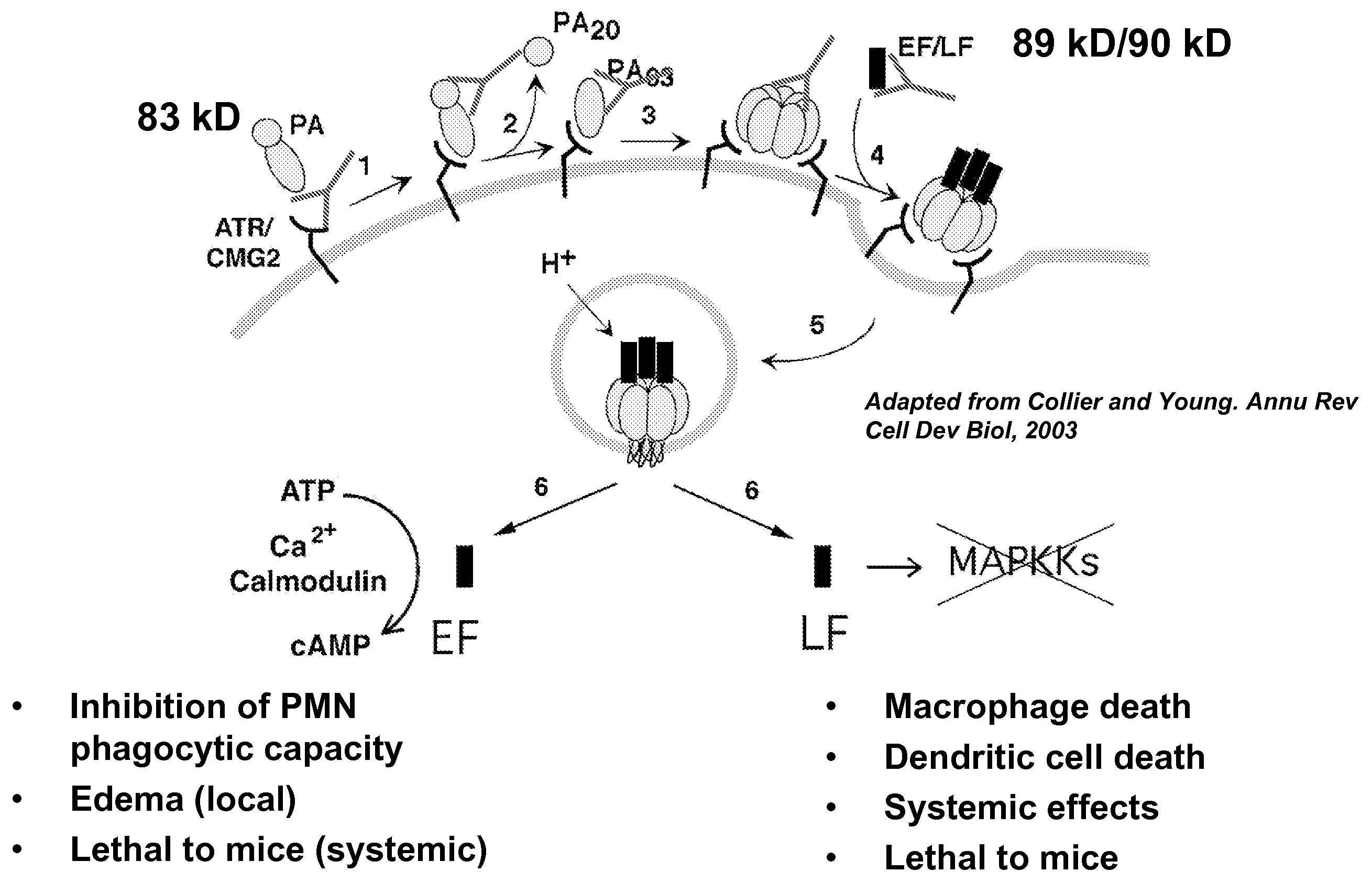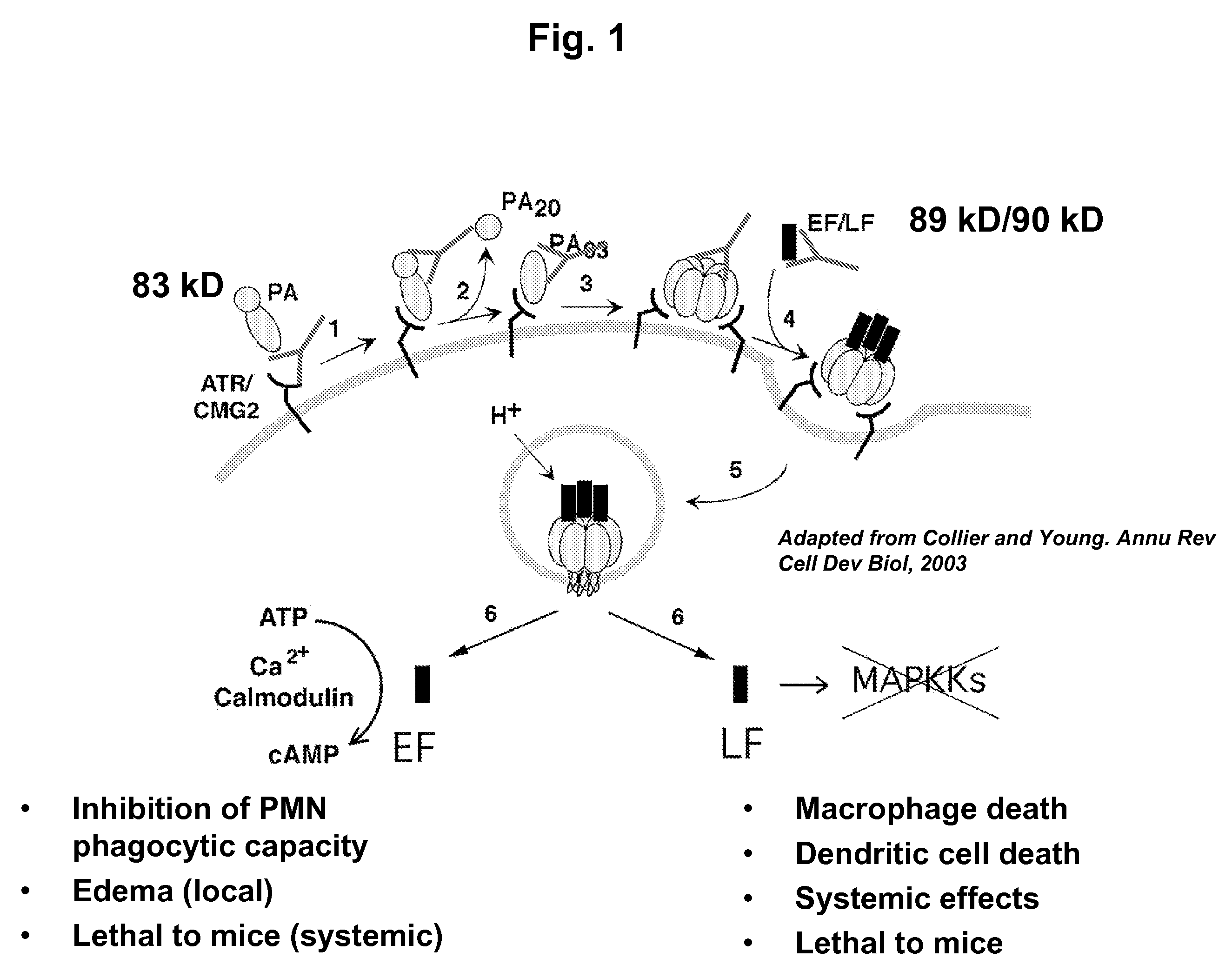Anthrax compositions and methods of use and production
anthrax composition and composition technology, applied in the field of immunology, can solve the problems of limited treatment success, less chance of survival, and human workers working with animal products at risk of contracting anthrax, so as to prevent, reduce and treat the occurrence or spread of anthrax, prevent and reduce the effects of infection
- Summary
- Abstract
- Description
- Claims
- Application Information
AI Technical Summary
Benefits of technology
Problems solved by technology
Method used
Image
Examples
example 1
Generation of Mouse Anti-Sera Containing Protective Antibodies to Anthrax Lethal Toxin and Protective Antigen
[0152]FIG. 2 shows the study design used to immunize groups of A / J mice with recombinant PA, recombinant LF or with adjuvant alone. The initial immunization was conducted in the presence of Complete Freund's Adjuvant (CFA) on day 0 and boosters were given on days 10, 24 and 38.
[0153]Blood samples for antibody testing and epitope mapping were collected from individual mice four days after each boost and again before toxin challenge, which was conducted 70-80 days after the final boost.
[0154]FIG. 3 demonstrates verification that the immunized mice were producing robust antibody responses to the recombinant LF and PA immunogens. FIG. 3 shows IgG antibody titers to LF and PA as determined by ELISA using commercially available LF and PA preparations.
[0155]LF-immunized mice produced high titers of anti-LF antibodies at day 28, and PA-immunized mice similarly produced high titers of...
example 2
Lethal Toxin Challenge
[0156]Before conducting epitope mapping, the mice of Example 1 were studied to determine whether they had produced lethal toxin-neutralizing antibodies. To check this, the mice were challenged with a lethal dose of the anthrax lethal toxin, which is co-injected PA plus LF. The dose used was three times the LD50 dose as determined in 6 week old A / J mice (See FIG. 4).
[0157]Only one of seven mice in the control group survived the challenge.
[0158]In contrast nine of ten PA-immunized mice survived the challenged (p=0.009), and seven of eight LF-immunized mice (p=0.007) survived the challenge. These data suggested that the mice had produced toxin-neutralizing antibodies.
example 3
Epitope Mapping
[0159]To map anti-LF, anti-EF and anti-PA antibodies produced in immunized mice, sera was screened against a series of solid phase bound 10 mer peptides that overlap by eight amino acids (See FIG. 5). The overlapping decapeptides span the entire length of protective antigen (379 peptides), edema factor (396 peptides) and lethal factor (401 peptides).
[0160]The decapeptides were conveniently synthesized onto polyethylene rods in a 96-well format. In a modified ELISA technique, the pins were lowered into 96-well plates for various incubations and washed in between.
[0161]Each individual decapeptide for each Bacillus anthracis toxin component was tested for immunogenic activity. FIGS. 6 A and B demonstrates results obtained in mice for B cell epitopes of lethal factor.
PUM
| Property | Measurement | Unit |
|---|---|---|
| molecular weight | aaaaa | aaaaa |
| OD measurement | aaaaa | aaaaa |
| OD | aaaaa | aaaaa |
Abstract
Description
Claims
Application Information
 Login to View More
Login to View More - R&D
- Intellectual Property
- Life Sciences
- Materials
- Tech Scout
- Unparalleled Data Quality
- Higher Quality Content
- 60% Fewer Hallucinations
Browse by: Latest US Patents, China's latest patents, Technical Efficacy Thesaurus, Application Domain, Technology Topic, Popular Technical Reports.
© 2025 PatSnap. All rights reserved.Legal|Privacy policy|Modern Slavery Act Transparency Statement|Sitemap|About US| Contact US: help@patsnap.com



